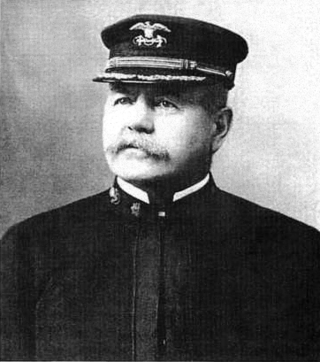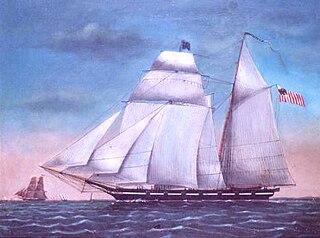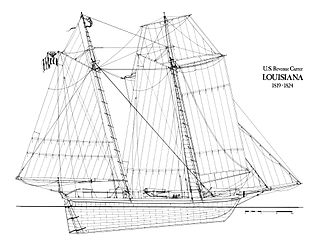
Frank Hamilton Newcomb was a United States Revenue Cutter Service commodore, best known for his actions at the Battle of Cárdenas during the Spanish–American War.

The United States Revenue Cutter Crawford was the first of the 13 cutters of the Morris-Taney Class to be launched. These cutters were the backbone of the U.S. Revenue Cutter Service for more than a decade. Samuel Humphreys designed these cutters for roles as diverse as fighting pirates, privateers, combating smugglers and operating with naval forces. He designed the vessels on a naval schooner concept. They had Baltimore Clipper lines. The vessels built by Webb and Allen, designed by Isaac Webb, resembled Humphreys' but had one less port
USRC Walter Forward was a schooner constructed for service with the United States Revenue-Marine. She was more commonly known as USRC Forward. Forward served with the United States Army and United States Navy in Mexican waters during the Mexican–American War and was commended for her actions during the Tabasco River landings by Commodore Matthew C. Perry, U.S. Navy. After the war, she was transferred to the United States Coast Survey for a short time as USCS Walter Forward before being returned to the Revenue-Marine for service during the 1850s and the American Civil War.
USS Howell Cobb was a schooner acquired on an emergency temporary basis by the United States Navy from the United States Coast Survey for service during the American Civil War. She served as a cargo ship in Union Navy service.

USRC Seminole was a 188 ft (57 m), 845-ton United States Revenue Cutter Service steamer constructed by the Columbian Iron Works in Baltimore, Maryland for $141,000. She was commissioned in 1900 and saw service through 1934, when she was transferred to the Federal Emergency Relief Administration.

USRC Massachusetts was one of the first ten cutters operated by the Revenue-Marine. She was built in Newburyport, Massachusetts, and served out of Boston. Massachusetts by tradition is held to be the first revenue cutter to enter active service. She was also the first to be decommissioned, having a very short service life of only about 15 months before being sold.

USRC Eagle was one of the first ten cutters operated by the United States Revenue-Marine, which later became the United States Revenue Cutter Service and later still became part of the United States Coast Guard.

USRC Manning was a revenue cutter of the United States Revenue Cutter Service that served from 1898 to 1930, and saw service in the U.S. Navy in the Spanish–American War and World War I.
USRC Forward was a revenue cutter constructed for the U.S. Revenue Cutter Service in 1882 by Pusey & Jones shipyard in Wilmington, Delaware. She was the second Revenue Cutter Service vessel named Forward and was named for Walter Forward, the fifteenth United States Secretary of the Treasury. The iron-hulled vessel originally cost US$72,750 and was powered by a two-cylinder steam engine with a topsail schooner brigantine sail pattern. Although Forward was considered a model ship at the time of its construction, it was severely underpowered and had unreliable machinery. The cost of repairs in the first fifteen years of operation was US$52,000.
The USRC Miami was purchased by the Revenue Cutter Service from Arthur Leary for $25,000 and was formerly the Lady Le Marchant, a 115-foot schooner-rigged steamer with a hull of teak planks over oak frames. After outfitting she was stationed briefly in Washington, D.C.

The capture of the schooner Bravo was a naval battle fought in 1819 between United States Revenue Cutter Service cutters and one of Jean Lafitte's pirate ships.
USRC Alabama, was a wood-hull topsail schooner designed by William Doughty that was commissioned in the United States Revenue Marine from 1819 to 1833. Assigned the homeport of Mobile, Alabama, she sailed the Caribbean extensively with her sister ship, USRC Louisiana and was used mainly in anti-piracy activity.
USRC Richard Rush was a Dexter-class cutter of the United States Revenue Cutter Service which served in the coastal waters of the western United States and the Department of Alaska.
USRC Active, was a revenue cutter of the United States Revenue Cutter Service in commission from 1867 to 1875. She was the fifth Revenue Cutter Service ship to bear the name.
USRC Resolute, was a revenue cutter of the United States Revenue Cutter Service in commission from 1867 to 1872. She was the only Revenue Cutter Service ship to bear the name.
USRC Relief, was a revenue cutter of the United States Revenue Cutter Service in commission from 1867 to at least 1870. She was the first Revenue Cutter Service ship to bear the name.
USRC Harrison was the lead ship of her topsail schooner class, which was built and operated by the United States Revenue-Marine, later Revenue Cutter Service, between 1849 and 1856.
USRC Ingham was the second ship of the Harrison schooner class, which was built and operated by the United States Revenue Cutter Service between 1849 and 1856. She is the third ship of the Revenue Cutter Service to bear the name.
USRC Detector was a Wasp-class schooner built for and operated by the United States Revenue Cutter Service from 1825 to 1832. She is the second ship of the Revenue Cutter Service to bear the name.
USRC Black, also known as the Jeremiah S. Black, was a lead of her class schooner built for and operated by the United States Revenue Cutter Service, in service from 1857 to 1868. She is the only revenue cutter to bear the name.






